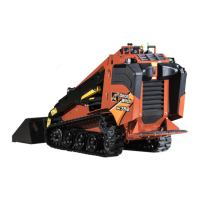
Do you have a question about the Ditch Witch SK752 and is the answer not in the manual?
| Operating Weight | 7, 110 lb |
|---|---|
| Engine Make | Kubota |
| Engine Power | 74 hp |
| Hydraulic Flow | 22.5 GPM |
| Gross Power | 74 hp (55.8 kW) |
| Fuel Tank Capacity | 16 gal |
| Horsepower | 74 hp |
| Fuel Capacity | 16 gal |
Provides helpful or important information or procedures not requiring specific order.
Contains illustration callouts or steps that must be performed in order.
General safety guidelines to follow before operating any jobsite equipment.
Product may contain chemicals known to cause cancer or birth defects.
Procedures to follow in case of electric strike, gas line damage, or fire.
Details on electric shock hazards and indications of an electric strike.
Actions to take if an electric line is damaged while on or off the tractor.
Procedures to follow if a gas line is damaged, including evacuation and contacting utilities.
Warning about vision damage and contacting utility company.
Steps to take if the machine catches fire, including shutdown and extinguishing.
Explains the meaning of DANGER, WARNING, and CAUTION safety alert levels.
Defines NOTICE for property damage and IMPORTANT for helpful tips.
Jobsite hazards could cause death or serious injury. Use correct equipment and methods.
Identifies lift point. See Transport chapter for more information.
Crushing weight could cause death or serious injury. Stay away.
Warns about moving parts cutting limbs and fire/explosion risks.
Locates tiedown points and emphasizes reading the operator manual.
Warns about crushing weight, securing cylinders, and hot parts.
Controls for track drive, steering, and parking brake.
Ignition switch for starting/stopping engine, throttle for engine speed.
Controls for lift arms and attachment drive, including foot pedal.
Describes how to connect and disconnect the battery using the switch.
How to use the level indicator for attachments.
How to lock and unlock attachments using latches.
Review job plan, arrange traffic control, plan for emergency services.
Notify one-call services and mark proposed path for underground utilities.
Locate overhead lines and ensure clearance.
Inspect jobsite for elevation changes, obstacles, and utility signs.
Wear PPE, comply with regulations, mark jobsite, keep spectators away.
Classifies jobsites based on hazards like electric lines or dust.
Precautions for working near electric lines, including hand digging and service shutdown.
Precautions for working near gas lines, including hand digging and gas shutoff.
Dust control measures and reference to OSHA guidelines.
General advice for avoiding other underground hazards.
Lists necessary supplies like fuel, keys, lubricants, and PPE.
Check fuel, hydraulic fluid, engine oil, and battery charge levels.
Check controls, parking brake, filters, tracks, hoses, etc.
Mentions fire extinguisher requirement.
Steps to connect an attachment, including positioning and engaging pins.
Procedure for connecting hydraulic hoses, with safety warnings about pressurized fluid.
Safety measures for connecting/disconnecting hydraulic hoses, including PPE and cooling.
Basic principles and safety for operating the machine, including load handling and terrain.
Factors and guidelines for safely operating the machine on slopes.
Procedures and safety for lifting the unit.
Steps and safety for loading the unit onto a trailer for hauling.
Identifies tie-down points and procedure for securing the unit.
Steps for safely unloading the unit from a trailer.
Steps for retrieving a disabled unit, including towing and brake bypass.
Steps to restore normal brake function after retrieval.
How to clean the equipment after use, with warnings about water spray.
Steps for safely disconnecting an attachment.
Ensure tools and accessories are secured for transport.
General safety precautions before performing service, including engine off and lowering attachments.
Safety measures and support use when working under raised lift arms.
Precautions to prevent damage to electronics during welding.
Lists recommended oils, fluids, and greases for the machine.
Symbols and their meanings for service tasks like checking levels and filters.
Specifies approved coolants and warnings about mixing types.
Fuel type and quality requirements for specified regions.
Fuel requirements for markets outside the US, Canada, EU, and Japan.
Procedure to check engine oil level using the dipstick and fill point.
How to check hydraulic fluid level using the sight glass.
Procedure to verify parking brake function.
Torque specifications for checking lug nuts at intervals.
Methods to check and adjust track tension using straight edge or gauge.
Procedure to check coolant level in the overflow bottle.
How to check the air filter service indicator.
Procedure for checking hydraulic hoses for leaks.
Initial procedure for changing engine oil and filter.
Initial procedure for changing the hydraulic filter.
Inspect fuel hose and clamp bands for wear or looseness.
Clean radiator and fluid cooler for debris.
Check lug nut torque at 50 hours and subsequent intervals.
Procedure to change engine oil and filter every 150 hours.
How to check fan belt tension and for wear.
Check the air intake line for dust and damage.
Change hydraulic filter every 300 hours.
Check lug nut torque at 300 hours and subsequent intervals.
Check idler roller bearing positioning and for movement.
Change fuel filters every 600 hours.
Change hydraulic fluid and filter every 600/250 hours.
Change fan belt every 600 hours.
Adjust valve clearance every 900 hours, requiring a technician.
Drain and refill cooling system with approved coolant every 1200 hours.
Adjust idler roller bearings to prevent damage from dirt and looseness.
Check battery for cleanliness and corrosion.
Procedure for safely charging the battery.
Table of dimensions for the basic unit, including height, length, and width.
Performance metrics like ground speed, ground pressure, and tipping capacity.
Battery specs and capacities for fuel, oil, and hydraulic reservoir.
Engine details like model, displacement, bore, stroke, and power ratings.
Specifications for hydraulic pumps, flow rates, and pressures.
Noise level ratings and vibration levels transmitted to operator.
How to notify dealer of malfunctions and order parts.
Information on obtaining publications, videos, and training.
Details the limited warranty policy for equipment and parts.
Lists conditions and damages not covered by the warranty.